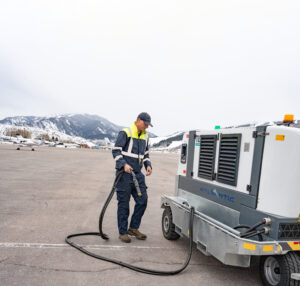An adage holds that ‘if you’ve seen one airport, you’ve seen one airport’ – essential wisdom that emphasizes the uniqueness of different airports. And while most airports have terrain, wind, and climatic conditions that are favorable for flight, at Aspen/Pitkin County Airport, USA high in the Rocky Mountains of Colorado, almost nothing is ideal, except perhaps for the willingness of the surrounding community to step into the fray to protect the environment and their quality of life.
“The Aspen/Pitkin County Airport is a single runway/single taxi way system at 7,838ft above sea level,” says airport director Dan Bartholomew.
Classified by the FAA as a Nonhub Commercial Airport, the designation indicates that the Aspen/Pitkin County Airport (ASE) receives less than 0.05% but more than 10,000 of the annual US commercial enplanements.
“Since the air is so much thinner, the density attitude at this elevation can lead to weight penalties on commercial aircraft, especially in the summer,” says Bartholomew.
“Due to the terrain, all air traffic takes off and lands to/from the north, which cuts our airspace capacity in half. Unfortunately, the present separation distance between our runway and taxiway limits us to aircraft with a maximum wingspan of 95ft.
“This airport faces a lot of unique considerations that impact not only flight operations, but ground operations, and how we interface with the surrounding community.”
While other airports in the USA may face difficult weather, challenging logistics, and constrained budgets, only very few face a curfew.

“ASE is the only airport in the US that has an absolute curfew. There are no flight operations between 11pm and 7am, with the exception of emergency flights. That was in place locally before The Aviation Safety and Capacity Expansion Act of 1990 and remains codified into the regulations,” continues Bartholomew.
Though the airport isn’t owned or operated by the City of Aspen, it lies just 3 miles (5km) northwest of the central business district of one of the most well-known ski towns in the world.
Bartholomew says, “One of the biggest advantages we have is that the community here is willing to do whatever is possible to make this airport more environmentally friendly. They insist on it.”
ASE, also known as Sardy Field, is county-owned and is for public use. Due to the airport’s local impact and importance, it is included in the City of Aspen’s emissions inventories. In 2017 the airport contributed 81,566 tons of CO2, which equates to 5% of all greenhouse gas (GHG) emissions in Pitkin County. The majority of that, 89%, is attributed to aircraft, according to the City’s 2019 GHG inventory report.
“There is a county resolution to reduce carbon emissions and noise by 30% by 2030,” says Bartholomew, of a mandate that must be met through multiple means. “In 2019 and 2020, we developed a baseline of energy and fuel emissions for the entire airport. We just installed electric vehicle charging for on-airport vehicles, and we will be installing monitors throughout the facility to gather data that we will model as we work toward meeting the required emissions reductions.”
Meeting the mandate set forth will not be easy or single-source. Bartholomew believes industry partnerships, such as it has with its sole-FBO Atlantic Aviation are essential for any effective optimization strategy.
“One of the things about our partnership with Atlantic Aviation is that as a third-party they can do things we, as the airport sponsor, can’t,” says Bartholomew. “Atlantic Aviation is committed to environmental stewardship, and it shows in everything they do.”
FBO vs airport

As an example of something an FBO can do in the US that an airport cannot, Atlantic has been buying carbon offsets for the fuel it pumps at ASE since 2020, including off-sets for all the fuel sold to others at the airport. Atlantic Aviation executive vice president, Clive Lowe, stresses the importance of right-fitting Atlantic services and solutions to the communities served.
“Atlantic Aviation is a USA-based, legacy business established in 1927. Today, we operate at more than 100 locations, in 37 states and a few surrounding international island locations,” says Lowe. “More than a major FBO, we see ourselves as an environmentally advanced, multi-billion-dollar aviation services and infrastructure operator. We are at many airports, large and small.
“Regardless of location, Atlantic’s objective is to be local everywhere. The people we employ are part of the community they serve, so what happens at their airport matters a great deal to them – not just operationally, but environmentally.”
At ASE, Atlantic serves as the commercial flight operator and the aircraft fuel operator. In tailoring its aviation services to each airport’s needs, Atlantic strives to synchronize its operational presence and processes around the specific objectives of the community served. For some airports, that means fostering economic development, at others, it means managing change. At Aspen, both Bartholomew and Lowe recognize the importance of environmental stewardship.
“The people of Aspen and Pitkin County are environmentally sophisticated. They well-informed about things like emissions and carbon, renewable energy, sound, and light pollution,” says Lowe. “ASE has become an environmental showcase for us because we strive to align with the communities’ priorities through the deployment of forward-thinking strategies at the airport.”
Eric Newman, Atlantic’s vice president of commercial strategy and sustainability sheds light on several ways Atlantic has moved toward optimization at ASE.
“On the ground side, we have been working toward a zero-emissions fleet through electrification for some time,” says Newman of a shift that began with moving to all-electric tugs in 2007. In 2018, Atlantic began converting its Aspen operations to LED lighting. “More recently, in support of the community’s desire for the airport to reduce carbon and noise emissions, we have made a push to electrify all ground equipment. Currently, we have achieved approximately 80% electrification.”
On the ground

Atlantic has now installed eight new all-electric ground power units (GPUs) at ASE, which is the largest investment in these units by any FBO provider in the USA. The move reduces greenhouse gas emissions by 180 metric tons of carbon dioxide equivalents annually.
“In the case of the GPUs, it is not just the carbon reduction, we also need to consider noise and pollutant reductions. The former units ran on diesel, which were loud and emitted particulates that travel in the air,” continues Newman. Atlantic also introduced some of the first all-electric fuel trucks at the ASE ramp.
“These pieces of equipment are very new, not generally available, and difficult to get to Aspen. So, the costs are very high. All of this must be looked at through a lens of commercial viability,” says Newman. “It is also important to understand that energy must come from somewhere. There is only so much available, and we don’t want to take load away from the community.”
Atlantic will continue to pursue meaningful partnerships with the City of Aspen around solar power and battery storage, while ASE continues to invest in betterments of their own.
“The airport is in the final stages of installing a micro-grid that will harvest solar energy, store it, and use it to handle dark sky events,” says Bartholomew of a pivotal point in ASE’s operations. “To this point, ASE has obtained electricity from the local utility through the grid. That left us vulnerable to a single point of failure anywhere along the line. The micro-grid allows us to use stored energy at night when we cannot generate it.”
As for what is next, Bartholomew wants to get a greater separation between the runway and existing taxiway to support larger aircraft.
“Modernizing our airfield will allow us to accommodate larger, cleaner, quieter aircraft,” says Bartholomew.
“It is important to note that in aviation, change and innovation are not as easy as flipping a switch.
“There are many other factors ranging from physics to regulatory requirements to geography, environmental concerns and beyond that, dollars and cents. So, we must look before we leap and not be myopic about what the future may hold.”






